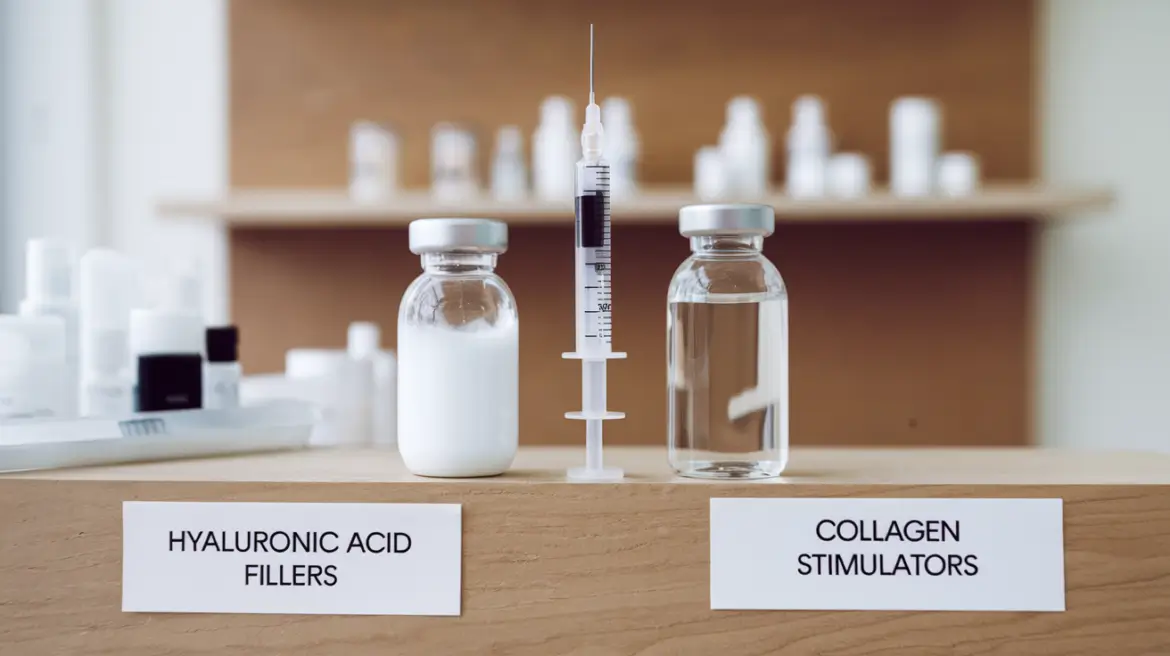The biggest difference between the biostimulating dermal fillers and the hyaluronic acid fillers is the material they are made from, which influences their mechanism and effect.
The hyaluronic acid fillers can immediately add volume to the face and enhance the contours in certain areas such as the cheekbones or lips, but they do not stimulate the collagen production. The biostimulating fillers, on the other hand, activate the collagen production, thereby gradually improving both the volume and the quality of the skin.
Hyaluronic Acid Fillers

The main ingredient in the fillers like Teosyal, Juvéderm, and Restylane is hyaluronic acid. The hyaluronic acid is a naturally occurring sugar in the skin and a key component in its ability to retain water. The hyaluronic acid used in fillers is synthesised in a laboratory to ensure it is free of bacteria and other contaminants. The hyaluronic acid fillers vary in their properties – viscosity, cross-linking, and their ability to provide lifting or volume. The degree of cross-linking of the hyaluronic acid, for example, can determine the hardness or flexibility of the product and define the area, for which it is most suitable. The fillers with a higher concentration of hyaluronic acid are often used to build volume and contour certain areas such as the chin and the jawline, the cheekbones, and the temples. They are great for adding volume to the back of the hands. Meanwhile, the lighter formulas with lower concentrations provide a softer and finer volume in the delicate areas such as the lips or the nasolabial folds.
When injected into the body, the gel-like consistency of the filler not only physically expands the tissue, but also absorbs water – up to 1,000 times its weight. This attracts the water molecules, adding volume and strengthening the surrounding structures, thickening the skin, and hydrating it. The effect can last from several months to a few years depending on the unique characteristics of the filler and the patient’s specific metabolism, which will determine how quickly the body absorbs the hyaluronic gel. It is also clinically proven that the injection of hyaluronic acid increases the body’s natural collagen production.
Unlike the biostimulating cosmetic fillers, the hyaluronic acid-based fillers can be broken down by hyaluronidase – something experts consider a gift, both aesthetically (if the correction needs additional adjustment) and from a safety perspective. However, the solvent has no effect on the biostimulating fillers with ingredients that gradually stimulate the collagen production.
Biostimulating Fillers

The biostimulating dermal fillers work by helping the body produce collagen, which increases the density and restores the firmness of the skin.
When treated with a biostimulating dermal filler, the patients can witness an improvement during the procedure, as the gel fills the wrinkles and adds volume. However, the optimal results appear after a few weeks since the collagen production stimulation is not immediate. This dual mechanism of action ensures that the results of this type of filler treatment last long after the gel itself is absorbed by the body.
Due to the increased collagen production that the biostimulating fillers induce, they provide long-lasting results without the need for repeating the procedures as often as with the hyaluronic fillers. However, if issues arise during the therapy – such as lumps or bumps – they are irreversible. Sometimes the more persistent nodules may require medication treatment.
Generally speaking, the potential side effects for both types of fillers are similar, with the most common being bruising, swelling, and redness. The allergic reactions and foreign body reactions, which manifest as lumps, are more commonly associated with biostimulating fillers (due to the nature of their ingredients) and can form at any time after the injection – even years later.
Which Type of Filler is Right for You?
This depends on several factors, but primarily: which part of the face or the body you want to improve, as well as the degree of volume loss. The biostimulating and hyaluronic fillers can be used together or separately, depending on the patient’s specific goals. The biostimulating fillers are ideal for the patients with more extreme or large volume losses, as well as for those needing a repeated facial and body rejuvenation.
The hyaluronic acid-based fillers yield shorter-term results. Their effects are immediate but last from 6 to 12 months. The biostimulating fillers provide gradual and longer-lasting results, aiding in the natural recovery of the larger and significantly more sunken areas. However, the corrections with them are irreversible, as they cannot be broken down and require more extensive skills and know-how on the part of the injector. They are certainly not for someone getting fillers for the first time. As with any other procedure, the expectations must be realistic.
The biostimulating dermal fillers can add much more volume than the hyaluronic acid fillers and are ideal for treating large areas affected by facial atrophy. They can enhance the appearance of the facial contour by improving the temples, the jawline, the midface, and the cheeks, and they can smoothen the skin by filling in the deep lines and the static wrinkles. The hyaluronic acid fillers are more suitable for restoring a moderate volume and filling in the fine to moderate lines and wrinkles.
Both the biostimulating cosmetic fillers and the hyaluronic acids are minimally invasive and do not require downtime after the treatment, which is a huge advantage over the surgical procedures.


